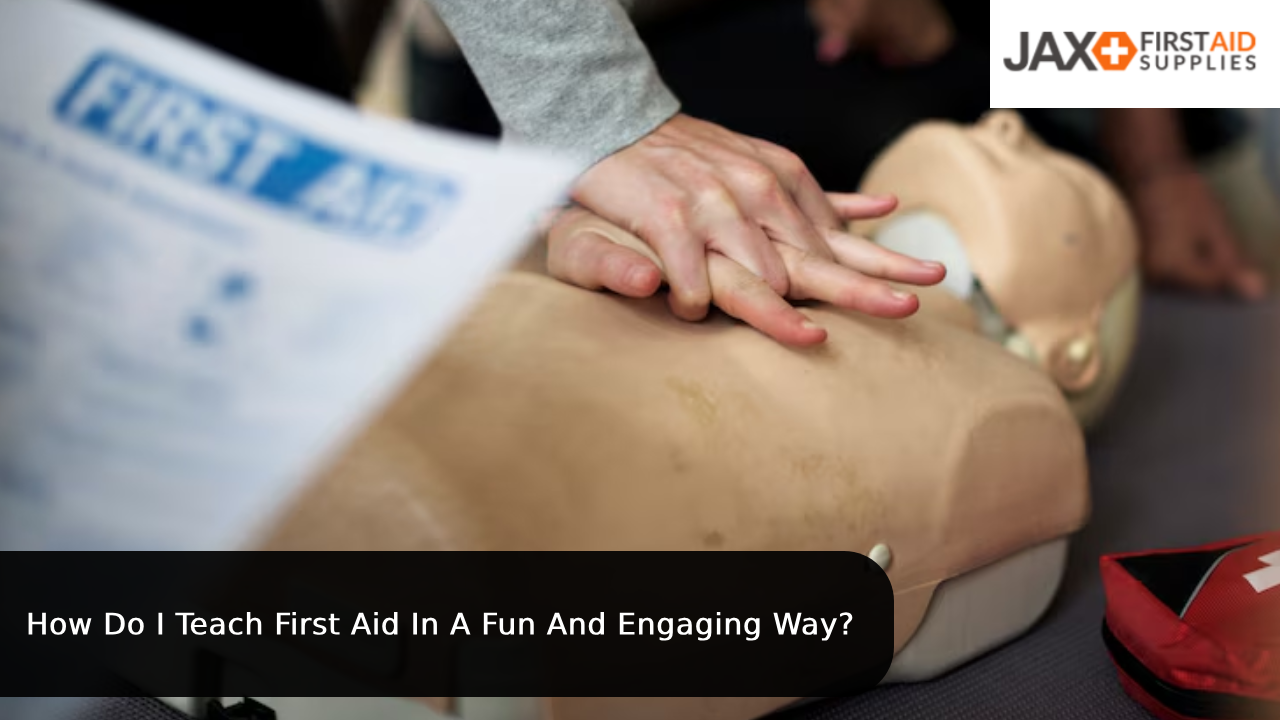How Do I Teach First Aid In A Fun And Engaging Way?
Published by Jax First Aid Supplies on 15th Apr 2025

Teaching first aid is highly important when it comes to forming a safer community; whether you are giving first aid training sessions in schools, workplaces, youth groups or any environment. But for a lot of first aid trainees, the idea of learning certain medical procedures and techniques can feel intimidating, or even boring. So, how can you teach your first aid sessions in a way that is not only fun, but also memorable and effective?
Make first aid learning active and hands-on
Learning hands-on, or “on the job”, can significantly improve your trainees’ retention of knowledge a lot more effectively. Rather than just talking through scenarios with just a regular slide show, make interactive first aid simulations. This doesn’t just mean physically involving them in exercises straight away, as they will still need to know the basics before using any practical equipment. You could use roleplay exercises, mock incidents, and timed response challenges to keep learners engaged - all while they are still sitting in their seats. Using an effective and interactive presentation, where roleplay and questions are involved can benefit your students massively.
For more physical activities, simple props like first aid training kits can make all the difference in training sessions. It is highly effective to encourage first aid learners to apply bandages, manage bleeding, or assess consciousness as part of your session.
Another highly beneficial activity is making sessions into an interactive and fun game. To boost enthusiasm, and the willingness to learn, consider dividing trainees into teams and rewarding points or giving a prize for correct procedures, answering questions or completing a task the quickest/most effectively.
Effective CPR training in first aid training sessions
CPR (Cardiopulmonary Resuscitation) is one of the most important skills in any first aid programme. In the UK, training in CPR is a part of the national curriculum in secondary schools, which ensures students are knowledgeable and ready for acting in an emergency scenario where CPR is required.
Including CPR into your training sessions doesn’t need to be complex. By using a CPR training bundle, you have everything you require to give structured, hands-on instruction. These bundles include multiple CPR manikins, CPR face shields, an act fast anti-choking vest, as well as guidance materials, which should be everything you need for practical CPR instruction.
It could be highly beneficial to your students to show learners, using a CPR manikin, how to check for breathing, perform chest compressions, as well as how to place someone into a recovery position. Realistic, hands-on practice can help to build confidence, as well as muscle memory for the case they are put into a CPR emergency later in life, meaning they can act without hesitation.
Visual aids and real-life scenarios
Visual learning can also help with trainee knowledge retention, as well as help to simplify information. Use posters or digital slides to break up practical exercises, and to show each first aid process step by step.
It could be helpful to link training to real-life stories or news articles, which gives context and emotional resonance. For example, by sharing how someone’s fast first aid response saved a life, you could inspire learners, and show the relevance of what they're practising to real life examples.
Age-appropriate and inclusive training
Each different age group will respond to teaching styles differently. Younger children will tend to care more for games, storytelling and interactivity, while older first aid learners may prefer clear demonstrations and case studies or examples from real life.
Using first aid tools for the right age groups, such as child first aid kits for children, can help make your first aid training sessions feel more relevant and inclusive for the setting.
Being inclusive and diverse is also a very important thing when working with all age groups. Consider a female CPR manikin to incorporate into your training sessions, to give a more inclusive CPR training experience, and minimise hesitation for emergencies where a woman may require CPR assistance, due to fear of inappropriate touching.
Remember it is important to create a safe space when it comes to questions and discussion. Make sure all trainees feel valued and supported, especially when dealing with sensitive topics like injury or cardiac arrest.
While you can make your training sessions more entertaining and engaging, first aid training isn’t just about being fun; they are about improving knowledge retention, boosting confidence, and ultimately saving lives. It is good to have a balance of fun and information for the most effective training experience, and by arranging your first aid training sessions in the right way, and using the right equipment, your students should retain the most optimal amount of first aid information, and feel confident and prepared if they ever face an emergency.
Feel free to explore our wide range of CPR training bundles as well as first aid supplies to support and boost your next training session, as well as create a safer, more prepared community.







